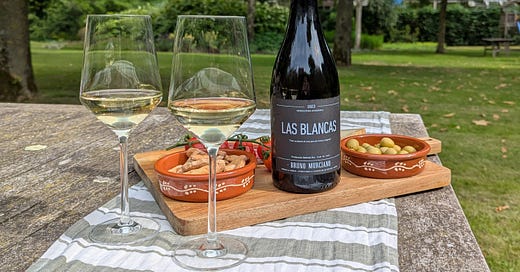Longer-term subscribers will know that I also write a regular column for DutchNews called Wine Watch. Each month, I pick a seasonal theme and recommend three wines – at different price points – that fit the brief and are available in shops in the Netherlands (although often elsewhere as well). As you’d expect, I taste far more wines than just those that make the final cut, and I also run out of space for food pairings and other info. So consider this your Wine Watch Expansion Pack: more wines, more food, more info!
For the summer months, I decided to focus on destinations that tourists (particularly from northern Europe) tend to go on holiday. The premise: to offer inspiration for your travels or suggest wines to look out for when you get home. July’s theme is Spanish whites: aiming for a sweet spot between the very well-known, widely exported bottles and the more obscure wines that are hard to find outside of Spain. You can read the original article here!
A little caveat
For various reasons, June was a shitshow of a month for me, so the notes that follow are not my most creative work… Most shockingly of all, I’ve not even been drinking (vino or any other alcohol) for the past ten days or so, which has made it harder to write convincingly about wine. Please bear with me until I can reclaim my wine mojo!
And now, on with the Expansion Pack – such that it is…
Rueda’s Verdejo wines
The Rueda region lies roughly between the Rioja region to the east and Portugal’s Douro Valley to the west, located on the high plains south of the Duero River. (Yes, Spain’s Duero and Portugal’s Douro are in fact two ends of the same river!) The signature grape from Rueda is Verdejo, which is why all my picks in this section are Verdejo-based. These wines are generally zesty, grassy, zippy little numbers – but of course, there’s a range of styles.
The
brothers recently wrote a helpful primer about Verdejo and Rueda, if you’re interested to learn more:In addition to the crisp, unoaked Emina Verdejo I recommended in my wine column (which has weirdly gone up in price since I submitted the piece a couple of weeks ago), I’ve also enjoyed the Arindo Verdejo by Bodegas Shaya made in a similar style (available via Decántalo) as well as Emina’s oak barrel-fermented Verdejo, which smooths out the acidity and adds toasty vanilla.
Rioja Blanco
Last November, I wrote extensively about my love of Rioja Blanco (white wines from the Rioja region, rather than the better-known Tempranillo-led reds) so I won’t repeat myself here. But do take a look at my earlier post if you’re curious:
Because of their specialism in Spanish wines, Decántalo is a useful store to stock up on good-value white Rioja. At the time of writing, they’re offering a 10% discount on everything and they also ship internationally. (You’ll find many of the wines I recommended in my article on “The Other Rioja” there too.)
Other lesser-known Spanish whites
Regions like Catalonia and Navarra (both in northeast Spain) are also producing some delicious, affordable, Rioja-esque whites. A few of my recent favourites include:
Llagrimes de Tardor Blanc: a tropical, full-bodied Garnacha Blanca from Terra Alta in Catalonia – available via Decántalo.
Tandem Inmacula: a ripe, almost oily Viognier/Viura blend from Navarra – available via Grapedistrict in the Netherlands.
Les Sorts Blancs: another Garnacha Blanca, this time from Montsant in Catalonia, with floral/mineral top notes underlaid with light, creamy oak – also available via Decántalo.
[Notes: In most cases I tasted a vintage earlier than the one currently available, as producers generally release their next vintage in summer. The links to wines on Decántalo are affiliate links, which means I make a small commission if you purchase wines via them. As you can probably tell from the gazillions of wines I’ve recommended in the past, the presence or absence of an affiliate programme doesn’t affect my wine picks - Decántalo genuinely is one of the best sites in Europe for Spanish wines.]
What to eat with Spanish wines
It’s been far too hot to cook in the Netherlands this past week, so I’ve been relying on hearty salads to sub in as main courses (Tuesday evening reached 34°C, which meant all I could make was tabbouleh, protein-ed up with shop-bought hot-smoked salmon). But of course, anything that counts as cold tapas – Jamón Ibérico, Manchego cheese, gildas (a skewer with anchovy, guindilla peppers and an olive), bread with aioli – would work wonders with a chilled glass of Spanish white. Fishy dishes or anything with lemon will work better with the crisp Rueda styles, while meats, cheese and fattier dishes will work better with the Rioja and other fuller-bodied styles.
When it’s finally cool enough to cook again, Spanish rice dishes are your friends. I’ve enjoyed making (and eating!) José Pizarro’s smoked pimentón clam rice with chorizo and roast peppers – swapping out the clams when they weren’t easy to get hold of. For a lighter, vegan-friendly take on paella, I recommend Ottolenghi’s multi-vegetable paella from his cookbook PLENTY – it’s an oldie, but still a goodie.
As always, thanks for reading! Let me know in the comments if you have any other top tips for Spanish whites, and feel free to like, share and all that good stuff…








Thanks for the shout out – verdejo is such a great hot-weather wine! Looks like availability of these recs is limited here in the US unfortunately (we need to up our verdejo and Rioja bianco game!), but gives us something to seek out next time we cross the mighty Atlantic. Cheers!